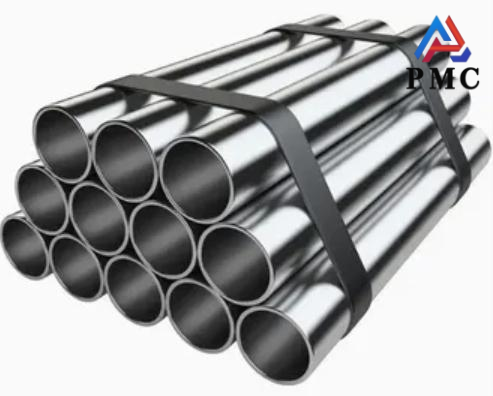
Seamless Steel Pipe Model Representation Method
The model representation method of seamless steel pipe is relatively complicated because it involves different standards, different uses and different classification methods. To accurately understand the model of seamless steel pipe, it is necessary to combine the specific usage scenarios and relevant standards.
1. Classification by production method
Hot-rolled seamless steel pipe: usually expressed by outer diameter, wall thickness and steel grade, for example: Φ108×4.5 20#, indicating a hot-rolled seamless steel pipe with an outer diameter of 108mm, a wall thickness of 4.5mm, and a material of 20# steel.
Cold drawn (rolled) seamless steel pipe: Similar to hot rolled pipe, it is also indicated by outer diameter, wall thickness and steel grade, but the words "cold drawn" or "cold rolled" will be added in front, for example: cold drawn Φ25×2 10#, which means a seamless steel pipe with a cold drawn outer diameter of 25mm, a wall thickness of 2mm and a material of No. 10 steel.
2. Classification by purpose
Different uses correspond to different standards, and the model representation methods of seamless steel pipes are also different.
Seamless steel pipe for structure (GB/T 8162): Mainly used for general structure and mechanical structure. The model is usually indicated by outer diameter × wall thickness, for example: Φ100×6. Sometimes the steel number is also added, for example: Φ100×6 20#.
Seamless steel pipe for fluid transportation (GB/T 8163): Mainly used for conveying water, oil, gas and other fluids. The model representation method is similar to that of seamless steel pipe for structure, and is also often represented by outer diameter × wall thickness, for example: Φ57×3.5.
Seamless steel tubes for low and medium pressure boilers (GB/T 3087): Mainly used for manufacturing heating surface tubes, water-cooled wall tubes, economizer tubes, etc. of low and medium pressure boilers. The model is usually indicated by outer diameter × wall thickness, and the steel grade is indicated, for example: Φ42×4 20G.
Seamless steel tubes for high-pressure boilers (GB/T 5310): Mainly used to manufacture economizers, reheaters, water-cooled walls, superheaters, etc. on the heating surface of water tube boilers with high pressure and above. The model representation method is similar to that of low and medium pressure boiler tubes, and is also represented by outer diameter × wall thickness, and the steel grade is indicated, for example: Φ38×5 20G.
Seamless steel pipe for petroleum cracking (GB/T 9948): Mainly used in boilers, heat exchangers and fluid conveying pipelines in petroleum refineries. The model is usually indicated by outer diameter × wall thickness, and the steel grade is indicated, for example: Φ76×4 1Cr5Mo.
High-pressure seamless steel pipe for fertilizer equipment (GB/T 6479): Mainly used for chemical equipment and pipelines with working temperature of -40~400℃ and working pressure of 10~30Ma. The model is usually indicated by outer diameter × wall thickness, and the steel grade is indicated, for example: Φ159×8 20#.

3. Classification by cross-sectional shape
Round tube: This is the most common cross-sectional shape of seamless steel tubes, and the model representation method is as described above.
Special-shaped tube: refers to seamless steel tube with non-circular cross-sectional shape, such as square tube, rectangular tube, oval tube, etc. The model representation method of special-shaped tube is more complicated, and usually needs to be described according to the specific cross-sectional shape and size, for example: 50×30×4. It means a rectangular tube with side lengths of 50mm and 30mm and a wall thickness of 4mm.
4. Steel grade indication method
Steel grade is an important identifier of the chemical composition and mechanical properties of steel. Different standards have different ways of indicating steel grades.
Chinese Standard (GB/T): Commonly expressed by a combination of numbers and letters, for example: 20, Q345B (Q345B seamless pipe), 20G, 1Cr5Mo, etc.
American Standard (ASTM): Usually represented by a combination of letters and numbers, for example: A106, A53, A335, etc.
German Standard (DIN): Usually represented by a combination of numbers and letters, for example: St37, 1.0425, 1.4571, etc.
Japanese Standard (JIS): Usually represented by a combination of letters and numbers, for example: STPG370, STB340, etc.
5. Examples of seamless steel pipe models
GB/T 8163-2018 Φ114×6 20#: indicates seamless steel pipe for fluid transportation that complies with GB/T 8163-2018 standard, with an outer diameter of 114mm, a wall thickness of 6mm, and a material of No. 20 steel.
ASTM A106 Gr.B Φ2″ Sch 40: Indicates seamless steel pipes that conform to ASTM A106 standards, with grade B, a nominal diameter of 2 inches and a wall thickness of Sch 40.
Read more: How to ldentify the Material and Specifications of SMLS Steel Pipes?


